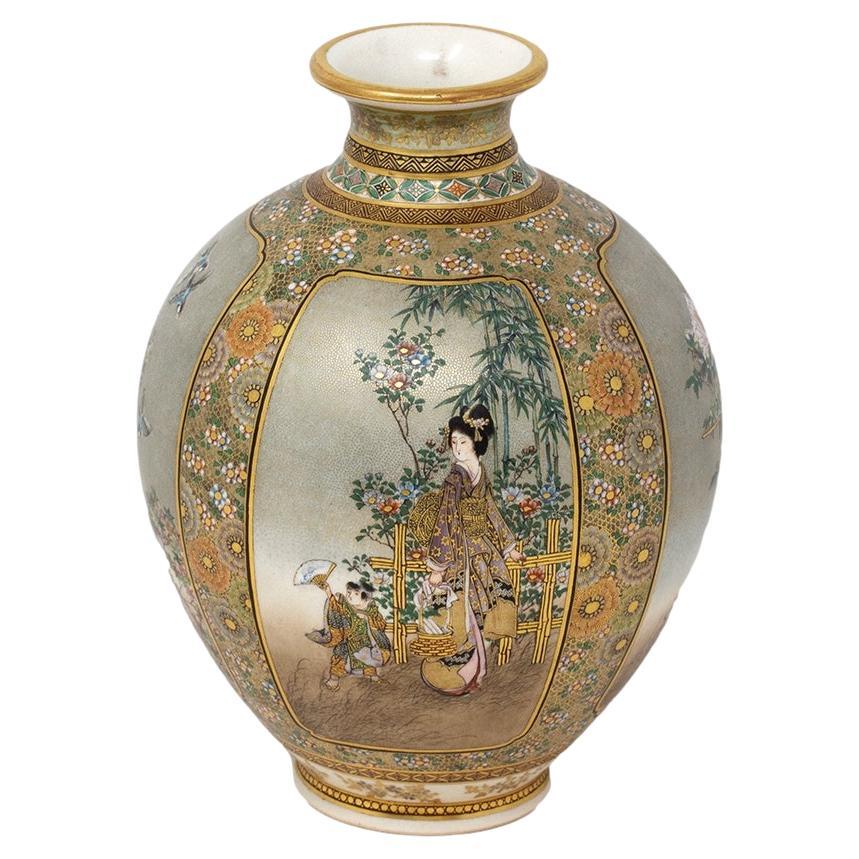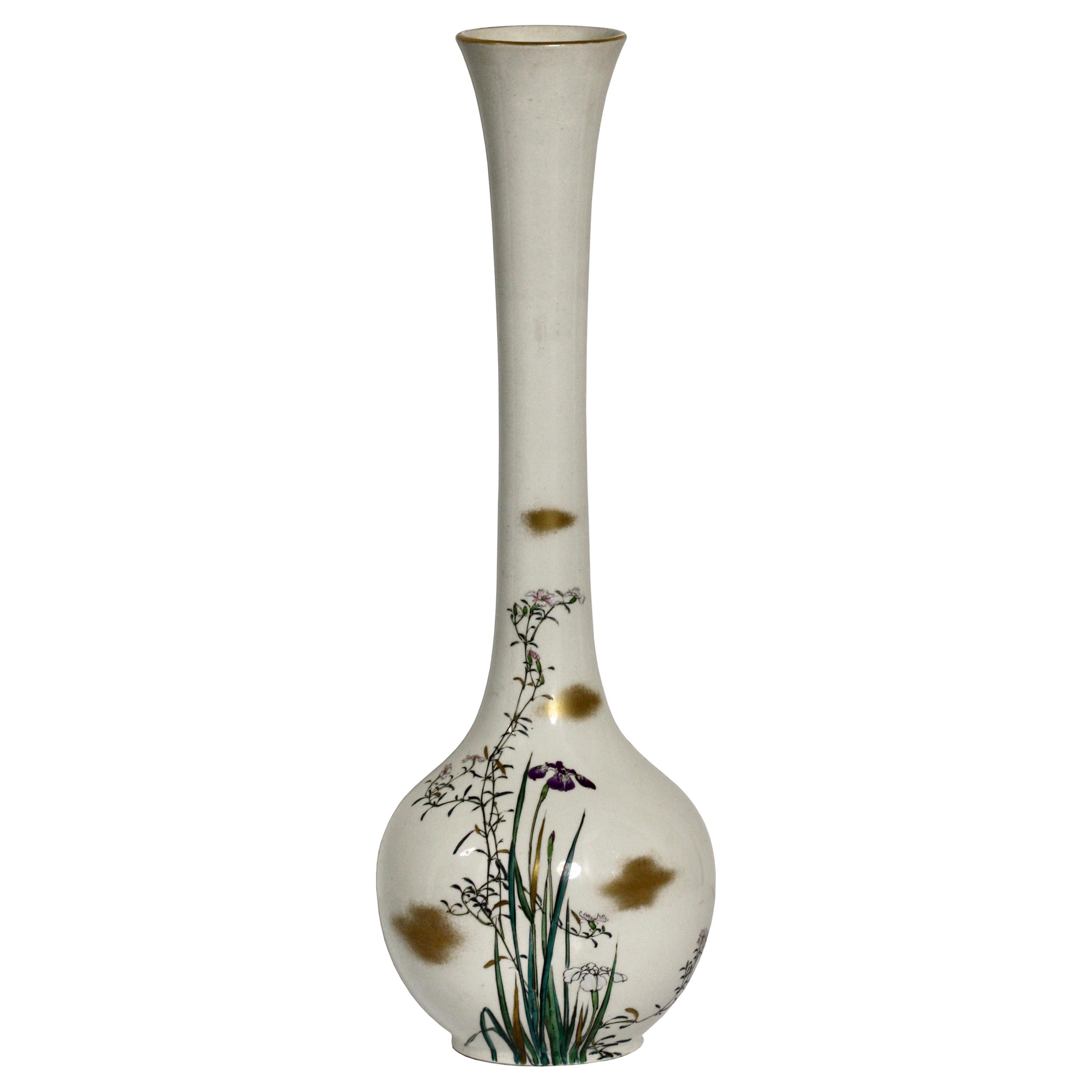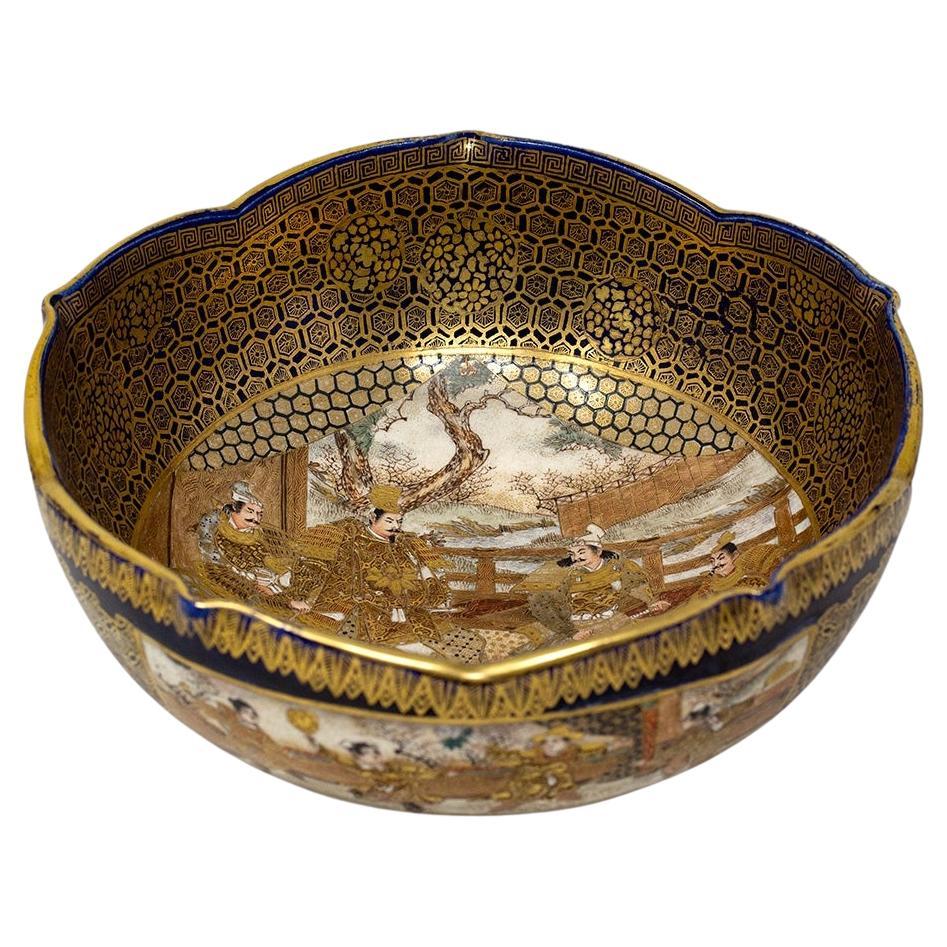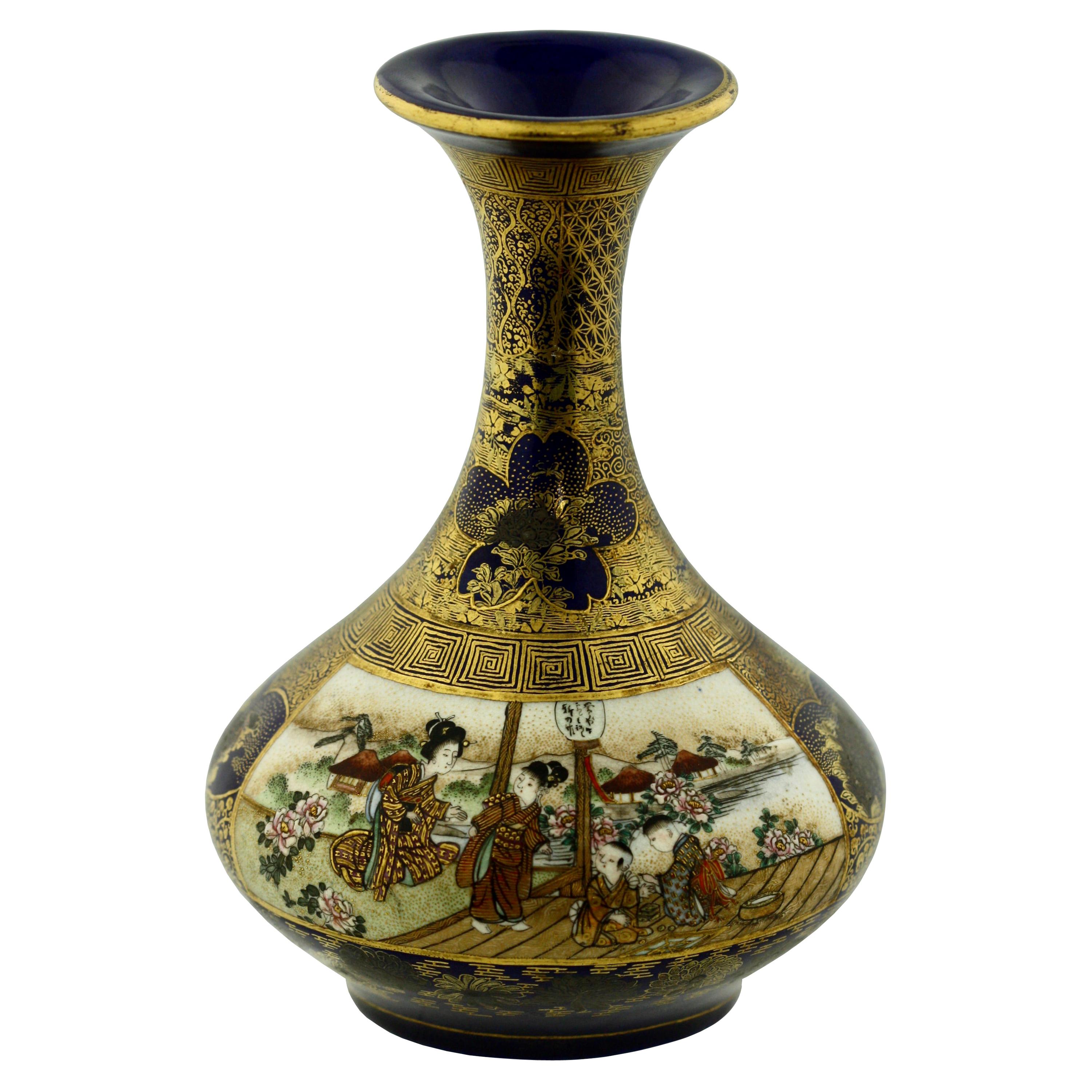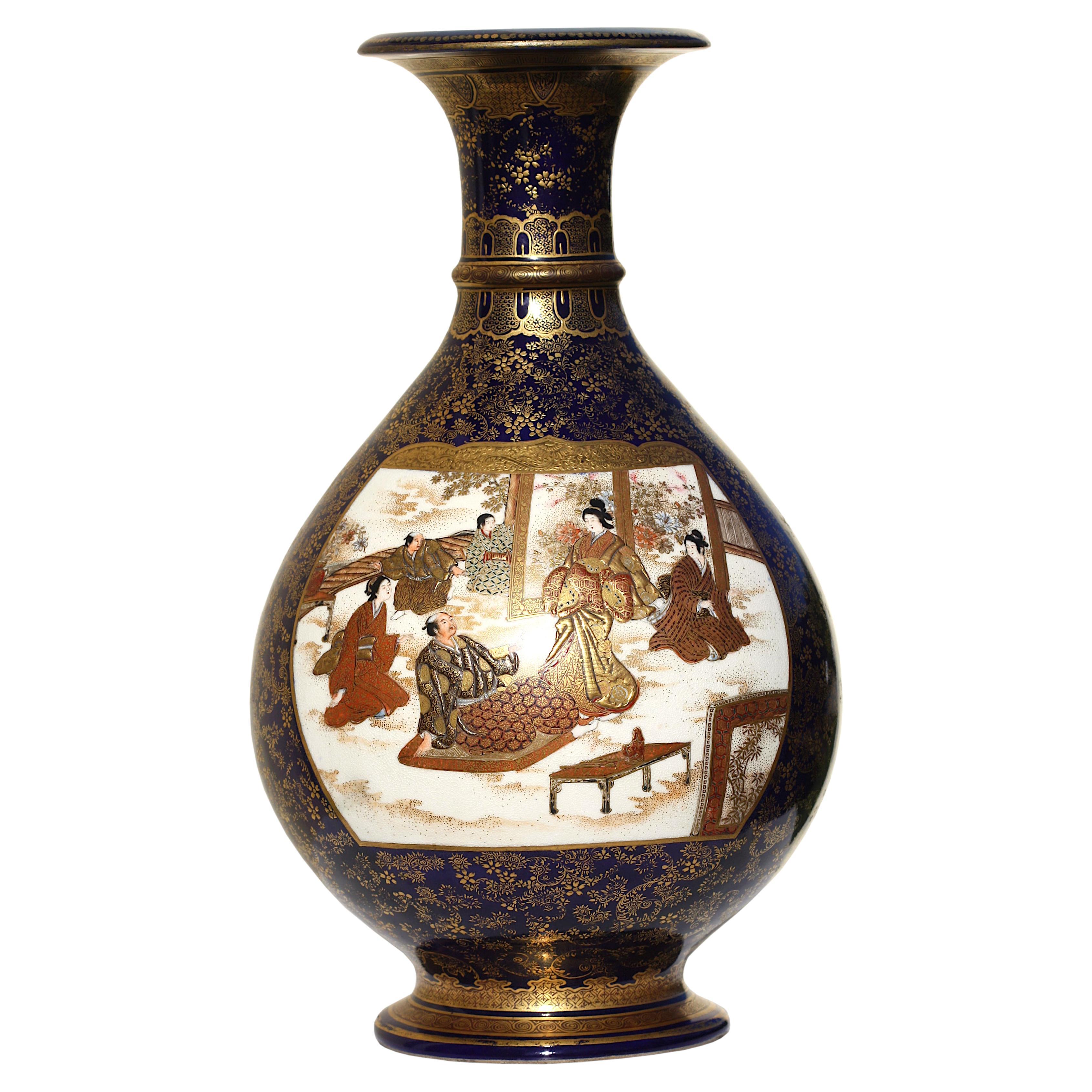Items Similar to Satsuma earthenware vase by kinkozan, Meiji period
Want more images or videos?
Request additional images or videos from the seller
1 of 6
Satsuma earthenware vase by kinkozan, Meiji period
About the Item
the body of this small marvelous vase is painted with a scene of a puppet show vendor with his wood backpack, on top of the backpack there are toys and dolls, he is surrounded with a group of 6 children, and on the background you can see a village.
on the other side of the vase there is an amazing painting of flowers and on the sides there are two amazing strong pine trees, the amorphous background is decorated in a "Tortoiseshell" color and design that gives it a real character and which is quite rare to see on satsuma pottery.
all the vase is over richly overpainted over the glaze with gold, which gives it its depth and realism.
signed Kyoto Kinkozan zo, and sealed Kinkozan zo
Kyoto’s Satsuma:
The painting technique used in Kyoto’s Satsuma-style ware is said to be the invention of the sixth generation Kinkōzan Sōbei (1824–1884). The Kinkōzan were a famous family of Kyoto Awataguchi potters who made ceramics that were used at Shōren'in, a temple closely tied to the imperial family, and by the shoguns of the Edo government. In fact the shogun is said to have granted them the name Kinkōzan. With the upheavals at the end of the Edo period, however, and the reforms of the subsequent Meiji government, the potters lost their traditional patrons and had to develop new markets.
Just at that time, the visit of a certain Westerner is said to have decided them to embark on overseas trade. By 1870, they had perfected Kyō Satsuma’s glazing technique and by 1872 they began their export in full scale. The Kyō Satsuma techniques invented by Kinkōzan Sōbei VI were then passed down to his son, Kinkōzan Sōbei VII (1868–1927), who further developed the ware.
Kinkōzan Sōbei VII (1868–1927)
The Kinkōzan continued to enlarge their business throughout the Meiji period to the point where the production of Kyō Satuma exceeded the original Satsuma made in Kagoshima.
Kinkōzan's climbing kilns
At the point of peak production, Kyoto's Satuma kilns boasted over 700 workers within a production complex over 4000 square meters in size. The ceramics were produced from two types of local clay taken from the outskirts of Awadaguchi and two types of clay from Koga in the neighboring Shiga prefecture. Painting, packing, and selling were taken care of within Kinkōzan workshops. At the time, Awataguchi was so crowded with ceramic workshops—including Obiyama, Yasuda, and Kusube—that it was said that the flames of the Awadaguchi kilns burned through the day and night.
The numerous collections of Kyoto Satsuma in Europe and the U.S. bespeak the success of Kyō Satsuma on the export market. Among the numerous museums with Kyō Satsuma holdings are the Victoria and Albert Museum in the U.K., the Guimet Museum of Asian Art in France and the Philadelphia Museum of Art in the U.S., which house Kyō Satsuma vases, incense burners, bowls, and dishes in their collections.
Kyō Satsuma production was initiated with an eye on the international market, and it reflects the trends of the late 19th century soon after Japan had reopened its doors, depicting Japan as the West wanted to see it. The heavy use of gold, the typical Japanese paintings of genre scenes or birds and flowers, and the many coffee cups and teapots produced all catered to Western preferences and life styles. Pairs of vases were frequently used as lamps or as decorations for fireplaces.
About the Seller
No Reviews Yet
Vetted Seller
These experienced sellers undergo a comprehensive evaluation by our team of in-house experts.
1stDibs seller since 2023
- ShippingRetrieving quote...Ships From: Tel Aviv - Jaffa, Israel
- Return PolicyA return for this item may be initiated within 14 days of delivery.
More From This SellerView All
- Amazing Japanese silver teapot and cover, dragon spout Meiji period 19TH centuryLocated in Tel Aviv - Jaffa, ILamazing rare archaistic style silver ewer or tea pot with cover, the design is Of archaistic style dragons on the main frieze and on the cover, this style came from ancient Chinese a...Category
Antique 1890s Japanese Metalwork
MaterialsSilver
- ÉMILE GALLÉ 'Iris' Vase, circa 1900 overlaid cameo and fire polished glassBy Emile GalléLocated in Tel Aviv - Jaffa, ILÉMILE GALLÉ (1846-1904) Rare and important 'Iris' Vase, circa 1900 Overlaid cameo and fire polished glass, well documented in books and exhibitions Signed in cameo Gallé. Measuremen...Category
Early 20th Century French Art Nouveau Vases
MaterialsArt Glass, Blown Glass, Cut Glass
- ÉMILE GALLÉ Vase, circa 1900 overlaid cameo glass red flowers, square shapeLocated in Tel Aviv - Jaffa, ILAn attractive late 19th Century cameo glass vase of elongated square form cut with decorative burgundy and red flowers against a warm yellow background with excellent hand finished d...Category
Antique 1890s Vases
MaterialsCut Glass, Blown Glass, Art Glass
- Rare Daum Nancy Wheel-Carved Rose 'La France' double overlay Cameo Glass VaseBy DaumLocated in Tel Aviv - Jaffa, ILThis wonderful, elegantly shaped with a flared rim vase , by Daum Nancy, features wheel-carved cameo glass of the highest quality detailing an amazing pink roses, or rose of France ...Category
Vintage 1910s French Art Nouveau Vases
MaterialsArt Glass, Blown Glass, Cut Glass, Opaline Glass
- Decorative Judaica Passover plate by Heinrich Schwed. Munich, 1924.Located in Tel Aviv - Jaffa, ILDecorative Passover plate by Heinrich Schwed. Munich, 1924. ALPACA, etched. This Large plate, featuring a round medallion in the center, with a Matzah which in this plate is hand c...Category
Vintage 1920s Platters and Serveware
MaterialsAlpaca
- exceptional George III teapot by preeminent silversmith Paul Storr, 1793By Paul StorrLocated in Tel Aviv - Jaffa, ILThis rare and exceptional George III teapot is the work of preeminent Georgian silversmith Paul Storr, it is one of his earliest works, the date mark on this pieces of the year 1793 which is the first year Storr marked items with his own initials (P S) The teapot is designed in the neoclassical taste with some Chinese influences, or Chinoiserie taste, even the figure on the cover of the teapot is Chinese. It is very hard to impossible to find works from this early period with this interesting Royalty provenance. The family crest on the front is of the Tollemache family, and dating of The teapot indicate It belonged and probably commissioned by or as a gift to William Manners Tollemache, Lord Huntingtower, William, On 12 January 1793, at the Age of 26, he Was created a Baronet, of Hanby Hall in the County of Lincoln. So this teapot was commissioned to celebrate the occasion. William Manners Tollemache: Lord Huntingtower (19 May 1766 – 11 March 1833), known as Sir William Manners, Bt, between 1793 and 1821, was a British nobleman And Tory politician. Born William Manners, he was the eldest son of John Manners and Louisa Tollemache, 7th Countess of Dysart. On 12 January 1793, at the age of 26, he was Ceated a Baronet, of Hanby Hall in the County of Lincoln.On his mother's Succession to the earldom in 1821, he was styled Lord Huntingtower, and adopted The surname of Talmash or Tollemache Paul Storr: (baptised 28 October 1770 in London – 18 March 1844 in London) was an English goldsmith and silversmith working in the Neoclassical and other styles During the late eighteenth and early nineteenth centuries. His works range from Simple tableware to magnificent sculptural pieces made for royalty Paul Storr was England's most celebrated silversmith during the first half of the Nineteenth century and his legacy lives on today. His pieces historically and Currently adorn royal palaces and the finest stately homes throughout Europe and The world. Storr's reputation rests on his mastery of the grandiose neo-Classical Style developed in the Regency period. He quickly became the most prominent Silversmith of the nineteenth century, producing much of the silver purchased by King George III and King George IV. Storr entered his first mark in the first part of 1792, which reflects his short-lived partnership with William Frisbee. Soon after, he Began to use his PS mark, which he maintained throughout his career with only Minor changes. His first major work was a gold font commissioned by the Duke of Portland...Category
Antique 1790s English Neoclassical Tea Sets
MaterialsSilver
You May Also Like
- Japanese Meiji Period Satsuma Vase by KinkozanBy KinkozanLocated in Newark, EnglandThe vase is potted in globular form with a tightly pinched neck and rolled top rim beautifully decorated with four highly detailed individual panelled scenes. The first a Geisha bari...Category
Antique Late 19th Century Japanese Meiji Ceramics
MaterialsCeramic, Earthenware, Pottery
- Kinkozan, Japanese Satsuma Vase, Meiji PeriodBy KinkozanLocated in West Palm Beach, FLKinkozan, Japanese Satsuma vase, Meiji Period (1868-1912) Of baluster form with an elongated neck decorated in polychrome enamels and gilt on a clear crackle glaze in an Art-Nouvea...Category
20th Century Ceramics
MaterialsCeramic
- Japanese Meiji Period Satsuma Bowl KinkozanBy KinkozanLocated in Newark, EnglandFrom our Japanese collection, we are delighted to offer this Japanese Meiji period Satsuma Bowl by Kinkozan. The earthenware bowl with pinched rim extensively decorated on both the exterior and interior. The bowl with a cobalt blue base glaze decorated to the borders with gilt shippo-tsunagi (linked-cash) with scattered medallion roundells. Around the exterior two elongated scenes are featured, one with boys playing games in a courtyard with the other featuring seated scholars in full dress both with raised enamel decoration. The interior features a central scene with Samurai warriors in training fully armoured with swords in a courtyard with landscapes scenes to the background. The central scene bordered by further stylised shippo-tsunagi type decoration with a greek key rim border. The bowl signed to the base Kinkozan dating to the Meiji Period (1868-1912) circa 1900. Shippo-Tsunagi (linked-cash) or seven treasures, is a traditional Japanese geometric pattern that combines four ellipses in a circle. These ellipses repeat outward to then create more circles, symbolising eternal peace and happiness. Kinkozan the Kinkozan family have been associated with pottery dating back to 1645. They went on to become the largest producer of Satsuma ware by one individual company, from the end of the 19th century until 1927 after which the factory closed. By the 1850s Kobayashi Sobei (1824-84), Kinkozan Sobei...Category
Antique Early 1900s Japanese Meiji Ceramics
MaterialsCeramic, Earthenware, Pottery, Faux Leather
- Satsuma Earthenware Vase, by Kinkozan, Japanese, Meiji PeriodBy SatsumaLocated in West Palm Beach, FLA Satsuma Earthenware Vase, by Kinkozan, Japanese, Meiji period (1868-1912) decorated in polychrome enamels and gilt over a clear, crackled glaze, delicately painted with ladies and men, the reverse with a flowering garden with sprays of flowers, the neck with geometric and floral designs, a band of kifu heads in silver and gilt above the foot, on a midnight-blue ground, signed Kinkozan zo...Category
Antique 1860s Vases
MaterialsEarthenware
- Japanese Satsuma Earthenware Vase by Kinkozan, Meiji PeriodBy KinkozanLocated in West Palm Beach, FLA Japanese Satsuma Earthenware Vase by Kinkozan, Meiji period (1868-1912) The body inset with two panels, one depicting figures seated around a table, the other painted with a joyful scene in a shrine, all reserved on a blue ground decorated with a gilt flower pattern, signed Nihon Kyoto Kinkozan zo...Category
20th Century Antiquities
MaterialsCeramic
- Large Japanese Satsuma Vase by KinkozanBy KinkozanLocated in Christchurch, GBAs part of our Japanese works of art collection we are delighted to offer this finely decorated Meiji Period (1868-1912), Satsuma vase stemming from the highly regarded Kinkozan stud...Category
Antique Late 19th Century Japanese Meiji Ceramics
MaterialsCeramic
Recently Viewed
View AllMore Ways To Browse
European Incense Burner
Woods And Sons Teapots
Fireplace Surround Ceramic
Japanese Ceramic Vases And Bowls
Japanese Antique Dolls
Kutani Koro
Martaban Pair
Antique Monkey Dish
Bok Choy Bowl
Red Blue Japanese China
Akae Kutani
Cinnabar Wine
Sasaki Shoraku Iii
Kokei Kishi
Satsuma Hotei
Takahashi Porcelain
Tong Zhi
Tung Chih
